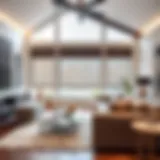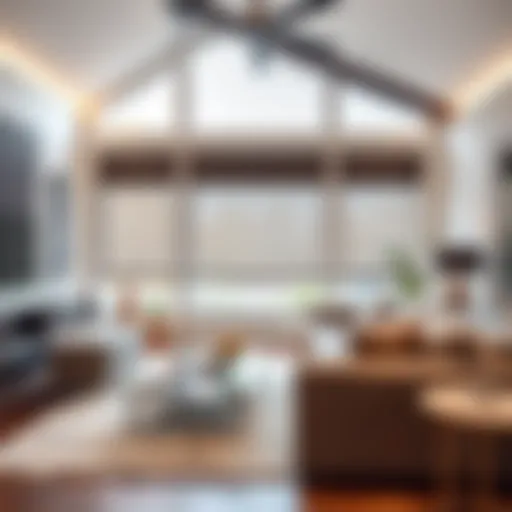Gray Modern Furniture: Style, Versatility, and Tips
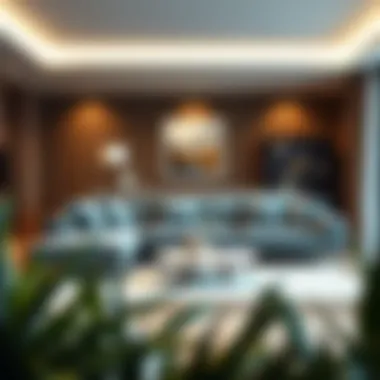

Intro
Gray modern furniture has made its mark in contemporary home decor, offering a perfect blend of sophistication and versatility. This hue transcends fleeting trends, standing as a timeless choice for homeowners, decorators, and designers alike. Whether one leans toward minimalist designs or opts for eclectic charm, gray furniture serves as a canvas upon which various styles can flourish.
Often seen as a neutral, gray can bring out the best in other colors and textures, allowing vibrant accents to pop without overwhelming the senses. It complements a range of materials from sleek metal to warm wood, making it a favored option in many living spaces. As you journey through this guide, prepare to uncover numerous facets of gray modern furniture and how it can elevate your interior environment.
Furniture Design Styles
Gray’s adaptability makes it suitable for a multitude of design styles. In this section, we will unpack key popular styles and explore how to mix and match them effectively.
Overview of Popular Styles
- Minimalist: Characterized by clean lines and simplicity, minimalist designs utilize gray extensively. Think low-profile sofas paired with streamlined coffee tables, allowing the space to breathe without unnecessary clutter.
- Scandinavian: Balancing functionality with aesthetics, Scandinavian design often features light wooden elements alongside gray furnishings. This combination creates a cozy yet modern vibe, embodying the warm, inviting essence of northern homes.
- Industrial: In loft-style living spaces, gray furniture marries well with raw materials like exposed brick and concrete. The rugged elegance of industrial design emphasizes a more utilitarian approach, marrying dark grays with blacks and deep colors.
- Contemporary: Regularly evolving, contemporary design seamlessly incorporates gray in various forms. From plush gray upholstery to sleek cabinetry, the color provides a chic backdrop that highlights sophisticated decor choices.
- Eclectic: For those who appreciate a mix of styles, gray serves as a unifier. It can harmonize diverse furnishings, lending an air of cohesiveness to a space filled with contrasting elements.
How to Mix and Match Styles
- Choose a Dominant Tone: Begin by selecting a primary shade of gray—light, medium, or dark. This will serve as the foundation for your design.
- Layer Textures: Use gray fabrics alongside different materials like leather, wood, or metal. This adds depth and visual interest to the decor.
- Complement with Accessories: Integrate colorful cushions or artwork that echo other elements in the room. This strategy will help pull the overall design together without overshadowing the gray base.
"In the world of design, gray furniture is not simply a choice; it's a statement of versatility and sophistication that reflects one’s personality and style."
Practical Tips for Homeowners
Integrating gray furniture into your living space can be as simple or as complex as you want it to be. Here are some essential tips and guidelines to ensure you make well-informed decisions.
Essential Buying Tips
- Assess Your Space: Measure your room before purchasing. Ensure the dimensions of the furniture match the scale of the space to prevent overcrowding.
- Quality Matters: Invest in quality materials, especially when it comes to upholstery. High-quality gray fabrics like velvet or linen not only look better but also last longer.
- Color Coordination: Look beyond just gray. Consider the hues of the other furnishings and walls to create a harmonious palette.
- Consider Functionality: Think about how you plan to use the furniture. Choose pieces that serve your needs while adhering to aesthetic preference.
Maintenance and Care Guidelines
- Regular Cleaning: Depending on the material, maintain cleanliness through different methods. For example, vacuum fabric upholstery weekly, while leather may require a specific cleaner.
- Avoid Direct Sunlight: Some materials can fade over time. Position furniture away from direct sunlight to maintain their hue and integrity.
- Stain Management: For incidents involving spills, act fast! Blot instead of rubbing stains to keep the fabric looking pristine.
By keeping these insights in mind, homeowners can seamlessly incorporate gray modern furniture into their spaces, unlocking a realm of design possibilities that can truly elevate the ambiance of their homes.
Understanding Gray in Modern Furniture
Gray has emerged as a vital player in modern furniture design, adding a layer of sophistication that transcends mere color choice. Its significance goes beyond aesthetics, influencing moods and perceptions in living spaces. In many ways, gray serves as a blank canvas, adaptable and versatile, allowing various styles and elements to shine without overwhelming the environment.
When it comes to interior design, color isn't just a visual element; it directly affects the emotional landscape of a space. Gray, in particular, strikes a harmonious balance between the starkness of white and the severity of black. This neutrality offers the perfect backdrop, making it easier to incorporate various accents and textures, truly a Swiss Army knife of colors in décor.
Moreover, the growing trend towards minimalism and the increasing popularity of urban lofts have made gray furniture a favored choice among designers and homeowners alike. Its understated elegance complements a range of elements—from lively artworks to textured fabrics—creating an inviting ambience. Also, this neutrality can foster a calm and focused environment, making it suitable for both relaxation and work spaces.
When considering gray furniture, it's also essential to pay attention to context. Depending on the finish and material, gray can evoke a sense of warmth or chilliness. For example, a warm gray can generate a cozy atmosphere, while a cool shade can appear more modern. Therefore, choosing the right hue and finish plays a crucial role in how gray will impact the overall feel of the room.
"Gray is not just a color, it's a statement. It's a shade that says sophistication without shouting for attention."
With an eye toward sustainability, many manufacturers are opting for eco-friendly materials in their gray collections. This blend of environmental consciousness and modern design resonates deeply with a growing demographic increasingly concerned with the sustainability of their choices.
To sum up, understanding gray in modern furniture isn’t merely about its visual appeal; it's about recognizing the psychological nuances it brings into a home. The blend of versatility, emotional resonance, and context makes gray an indispensable choice for those looking to elevate their living spaces through thoughtful design.
Design Styles Embracing Gray Furniture
Gray furniture isn't just another trend; it's more like a flexible chameleon, fitting into various design philosophies seamlessly. The incorporation of gray into modern design styles offers benefits beyond simple aesthetics. It balances out spaces, enhances versatility with color pairings, and even adds layers of sophistication that can elevate a room’s overall atmosphere.
Minimalism and Gray
Minimalism champions simplicity and functionality, and gray fits snugly within this framework. This style embraces the idea that less is more, favoring open spaces and clean lines. Gray furniture provides a neutral backdrop that allows for a clear focus on the design elements in the space. Think of a sleek gray sofa against white walls—there’s a distinct elegance that comes from this arrangement.


Choosing gray allows for a range of textures and materials without overwhelming the senses.
- Light gray tones offer a soft, airy feel.
- Darker grays evoke a sense of depth and warmth.
By opting for gray in a minimalist design, homeowners also reduce visual clutter, allowing for moments of tranquility in their living spaces.
Industrial Design Elements
Industrial design takes its cue from repurposed factories and warehouses, with an emphasis on raw materials and an urban vibe. Gray plays a pivotal role here, acting as the bridge connecting various elements.
The use of gray metal furniture or distressed wood brings the desired ruggedness without saturating the space. Consider:
- Gray metal chairs paired with reclaimed wood tables. They create an effortlessly chic look.
- Gray concrete elements, whether furniture or decorative accents, add both an industrial edge and a sturdy presence.
Incorporating gray into industrial design isn’t just about color; it’s about creating a narrative around the space that resonates with the history of materials as well as modern needs.
Contemporary Eclecticism
Eclectic design shakes hands with an array of styles while staying anchored to certain unifying themes. In this context, gray furniture serves as a grounding element amidst varied textures, patterns, and colors. You might find a bold, colorful rug under a gray sofa while vibrant art fills the walls. The juxtaposition adds character without causing chaos.
Here are key aspects to consider when introducing gray into an eclectic style:
- Gray as a base color: It allows other elements to shine, such as bright cushions or quirky art pieces.
- Varied materials: Mixing gray velvet, linen, and perhaps leather can elevate the entire aesthetic.
By thoughtfully integrating gray furniture, decorators encourage a harmonious blend of styles, encouraging individuality while evoking a sense of cohesiveness.
Gray furniture is not just a color choice; it's a versatile tool in the arsenal of design, adaptable across various styles.
Materials Commonly Used in Gray Furniture
Gray modern furniture draws on various materials, each contributing to the overall aesthetic while serving functional purposes. Understanding the characteristics of these materials is essential for making informed decisions that enhance both your decor and your space. Let’s break down the most prevalent materials used in crafting gray furniture, with a focus on what makes them special, their benefits, and some considerations for each.
Wood Varieties and Finishes
Wood is perhaps the most beloved material in furniture-making, offering a warmth and richness to interiors that synthetic options often lack. When it comes to gray furniture, various wood species can be employed, including:
- Oak: Known for its durability and versatility, oak can be treated to have a gray finish that accentuates its grain.
- Walnut: The deep hues of walnut can be paired with a gray stain, offering a sophisticated contrast that highlights both colors.
- Ash: Lighter in tone, ash wood can be enhanced with gray washes that preserve the natural beauty while giving it a contemporary twist.
The finishes of these woods—or even the absence of finish—play a significant role in how gray tones interact in your space. A matte finish, for instance, can provide a more understated elegance, while a glossy sheen makes the gray pop, enhancing the visual impact. This balance is crucial for achieving the desired atmosphere in a room. There's an unspoken rule that a sturdy piece of furniture should not only look pretty but should stand the test of time.
Metallic Accents and Frameworks
Metal is rapidly gaining ground in the world of gray modern furniture, especially when it comes to frames and accents. Materials like steel, aluminum, and brass are commonly used to create a robust structure while adding an industrial edge to the design.
Using gray metals offers a sleek appearance; for instance:
- Steel: Often powder-coated in gray, steel adds strength and durability to chairs and tables while keeping a modern vibe.
- Brass accents: A warm, muted brass serves as an eye-catching contrast against gray surfaces, providing a balance of texture and color.
Consideration should be given to rust and corrosion, particularly in humid environments, meaning protective coatings are essential. The right metallic finishes can change a piece from plain to striking, elevating the look of your decor. Integrating metals can not only enhance the aesthetics but also foster a dialogue between warmth and coolness in your design.
Fabric Choices for Gray Upholstery
When it comes to upholstery, the fabric can make or break the visual appeal of gray furniture. The texture and pattern of fabric influence how gray is perceived in a space. Different materials can evoke varying feelings and can significantly affect the comfort and durability of furniture.
- Linen: This natural fiber is breathable and has a unique texture that works well in softer hues of gray, enhancing the relaxed feel in living spaces.
- Velvet: For those looking to make a bold statement, velvet upholstery in a deep gray can add luxury and sophistication to any piece.
- Leather: Gray leather is another option, particularly in modern furniture, offering a refined and clean look. It's also easy to maintain, which is a plus for everyday use.
Choosing the right fabric also involves deciphering how it wears over time, with some materials fading or showing stains more prominently than others. Ultimately, your choice of upholstery should meld style with functionality and comfort, presenting a comprehensive view of your taste in design.
"Choosing the right materials is pivotal to the overall success of gray furniture in your home, impacting not just look, but feel."
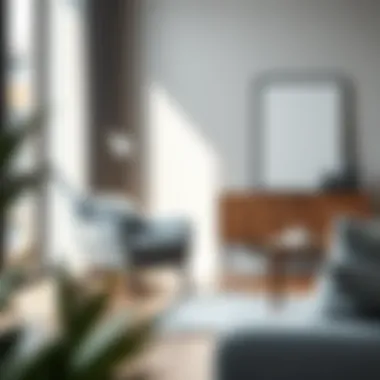

Each of these materials reflects a specific aspect of modern design and contributes to the overall experience of gray furniture. They play vital roles in the comfort, durability, and aesthetic appeal of the pieces that shape our living spaces. By understanding these materials better, you can select furnishings that not only align with your style but also stand the test of time and trends.
Integrating Gray Furniture into Your Space
In the realm of home decor, integrating gray furniture into your space is more than just a design choice—it’s an opportunity to create a cohesive and inviting environment. Gray, with its myriad shades, provides a neutral backdrop that enhances other colors and elements within a room. It seamlessly melds with various styles, acting as a common thread that ties different design elements together.
Pairing Gray with Other Colors
When it comes to pairing gray with other colors, the options are practically endless. Gray works well with both bold and understated tones. For instance, a soft gray couch can be beautifully complemented by deep burgundy or a fresh mustard yellow. Here are some combinations to consider:
- Dusty blue: This soft pairing can evoke a tranquil and serene atmosphere.
- Warm earth tones: Browns, terracotta, and greens blend effortlessly with gray, creating a natural, organic feel.
- Vibrant accents: Using bright colors like teal or fuchsia in the accessories or artwork against a gray base can create a striking visual contrast.
This versatility in color matching not only enhances the aesthetics of a room but also reflects personal style and creativity.
Important Note: Remember that lighting can affect how colors interact with gray. Test paint samples and fabrics in the light of your chosen space before committing.
Creating Contrast with Textures
Textures can elevate gray furniture in a room, making it more dynamic and inviting. The way light interacts with different textures can create depth, breaking up the monotony that purely color-based designs sometimes present. Here are several ways to incorporate texture alongside gray furniture:
- Soft textiles: Think cushions, throws, and curtains made from fabric like velvet or linen. These add warmth and comfort.
- Natural elements: Pair your gray pieces with wood or stone that adds an organic touch, enhancing the overall aesthetic.
- Metal accents: Using metal frames or hardware in chrome or brushed nickel can give an industrial edge that complements gray furniture beautifully.
By blending textures, a space that may initially appear flat becomes layered and engaging, capturing attention in all the right ways.
Placement Strategies for Balance
Placement of gray furniture plays a significant role in achieving visual harmony within a room. It's crucial to consider the function of each space and how furniture placements can facilitate movement and usability. Here are a few strategies to think about:
- Anchor large pieces: Use larger gray sofas or armchairs to define the area in an open space, making it feel more intimate.
- Symmetrical arrangements: Matching gray side tables on either side of a sofa can create a sense of equilibrium, guiding the eye smoothly across the room.
- Use height variations: Consider using varying heights in furniture and decor—mix low-slung gray sofas with tall art pieces or shelving, drawing the eye upward and adding dimension to the space.
Achieving balance through thoughtful placement can breathe life into your home, making spaces not just functionally sound, but also visually sophisticated.
Maintaining Gray Modern Furniture
Keeping gray modern furniture looking sharp requires some effort, yet it’s well worth it for maintaining elegance in your space. Gray, while neutral and versatile, also shows wear and tear more readily than you might think. By understanding how to properly maintain your pieces, you enhance their lifespan and preserve their aesthetic appeal.
Cleaning Techniques by Material
Different materials call for various cleaning approaches. Ignoring specific needs can lead to issues ranging from unsightly marks to irreversible damage. Here’s a breakdown of useful cleaning techniques based on the material used:
- Wood Furniture: Start by dusting with a soft, lint-free cloth. For deeper cleaning, mix a mild soap with warm water, dampen a cloth, and wipe down surfaces. Avoid soaking as water can warp wood. Follow up with a dry cloth to remove excess moisture. A good quality furniture polish can revive wood's natural shine.
- Leather Upholstery: Use a leather cleaner specifically designed for the type of leather used. Regularly dust and vacuum with a soft brush attachment. For stains, gently blot with a damp cloth—don’t rub, as it may damage the leather.
- Fabric Upholstery: For fabric, regularly vacuum to remove dirt and debris. Stains? Blot with a clean cloth, ideally using a mixture of mild detergent and water. Always test any cleaner on a hidden area first, as some fabrics can be sensitive.
- Metal Accents: Clean metal surfaces with a soft cloth to eliminate dust. For tougher stains, use a little warm soapy water. Be careful not to use abrasive materials that could scratch the surface.
Protective Measures Against Wear
Springing for beautiful gray furniture is an investment, so it’s crucial to take steps to shield your pieces from everyday wear. Here are practical measures:
- Coasters and Place Mats: Always use coasters for drinks, which prevents unsightly water rings on surfaces. Similarly, place mats can protect dining tables from scratches.
- Sun Protection: Position furniture away from direct sunlight. UV rays can cause fading and degradation over time. Use window treatments like curtains or blinds to manage light levels in a room.
- Regular Maintenance: Consider yearly touch-ups or treatments. For wood, this could mean reapplying polish or sealants. For fabric, a professional cleaning every year keeps upholstery fresh.
- Strategic Placement: Arranging furniture to minimize traffic can reduce the likelihood of accidental bumps and scratches. Additionally, avoid heavy items atop delicate surfaces as the added weight may cause dings or indentations over time.
Protecting your gray furniture is not just about keeping it clean; it's about maintaining its integrity and the overall aesthetic of your space.
Trends in Gray Modern Furniture
As the interior design landscape evolves, the role of gray modern furniture has never been more significant. This trend goes beyond aesthetic appeal; it resonates with a lifestyle that values both sophistication and versatility. Gray is not merely a backdrop; it’s a statement, a testament to the balance between functionality and form. By integrating gray tones, spaces transform into calming havens, appealing to various tastes from minimalistic designs to more eclectic decor.
One of the key aspects driving this trend is the increasing emphasis on sustainability. Consumers today prefer to choose pieces that are not only stylish but also environmentally responsible. This is where gray furniture shines - it often incorporates materials and designs that minimize ecological impact. Incorporating gray furniture helps achieve a modern and timeless aesthetic while aligning with the growing demand for sustainable practices in design.
Sustainable Materials and Practices
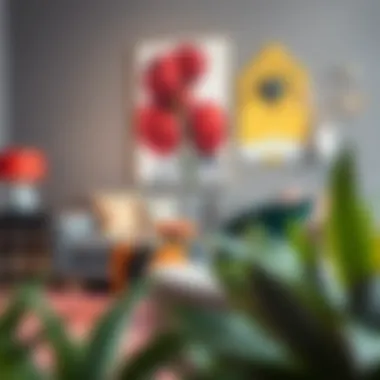

The trend of using sustainable materials in furniture design is on the rise, and gray furniture reflects this shift adeptly. Utilizing renewable resources like bamboo or reclaimed wood, furniture makers are minimizing waste while delivering quality craftsmanship. Additionally, many designers are opting for eco-friendly finishes and upholstery. Fabrics made from organic cotton or recycled materials not only enhance the beauty of gray tones but also contribute to a healthier living environment.
When considering gray furniture, look for products that have certifications from recognized environmental organizations. These certifications offer assurance that the materials used are responsibly sourced.
"Sustainability is not a trend; it’s an expectation that reshapes the future of design."
Moreover, incorporating gray modern furniture can lead to energy efficiency within home design. Lighter shades of gray can help reflect natural light, reducing the need for artificial illumination and improving the overall ambiance of the space.
Smart Furniture Integration
The integration of smart technologies in gray modern furniture is another trend gaining traction. With homes becoming more connected, designers are now creating pieces that not only serve a functional purpose but are equipped with technological enhancements. Think of sofas with built-in charging ports or tables with embedded speakers. This fusion of gray tones with smart features enhances the utility of furniture while maintaining a sleek and modern aesthetic.
As technology advances, the demand for multifunctional, adaptable furniture grows. Many consumers now seek pieces that can serve dual purposes, especially in smaller living spaces. Gray furniture can seamlessly blend into such environments, offering solutions that do not compromise style for practicality.
In summary, the trends in gray modern furniture signify a larger movement. They represent a commitment to sustainability, innovation, and a shift towards spaces that are not only beautiful but also functional and conscientious. Staying informed about these trends is essential for designers, retailers, and homeowners who wish to create visually compelling and environmentally responsible interiors.
Showcasing Gray Modern Furniture
When it comes to employing gray modern furniture in interior design, showcasing it effectively can elevate the entire atmosphere of a room. Gray, being an inherently versatile color, serves as a perfect backdrop enabling homeowners to sculpt a refined but comfortable aesthetic. This section will delve into ways to effectively incorporate gray furniture with distinct art and accessories, while also dissecting the significance of light in enhancing these choices.
Incorporating Art and Accessories
Art and accessories play a crucial role in the narrative that your space tells. When working with gray modern furniture, choosing the right pieces can turn an ordinary space into something extraordinary. Here are several tips to consider when integrating art and accessories:
- Contrast is Key: Since gray serves as a soft canvas, introducing vibrant artwork can create a striking contrast. Opt for bold pieces that incorporate colors such as deep reds, blues, or even bright yellows. For example, a large abstract painting on the wall behind a gray sofa can draw the eye and create a focal point.
- Textures Matter: Consider the textures of your accessories. Mixing different materials, like smooth ceramics with rough textiles, can add dimension. For instance, a plush gray chair complemented by a rusty metal sculpture creates an appealing visual juxtaposition.
- Personal Touches: Incorporate personal items like photographs or travel souvenirs to personalize the arrangement. This humanizes the space and brings warmth to the gray tones. A gallery wall featuring family images in various frames can enhance the overall aesthetic.
Utilizing art and accessories thoughtfully not only uplifts gray furniture but also weaves in your unique story, transforming gray’s neutrality into a beautiful personalized narrative.
Lighting Considerations for Gray Spaces
Effective lighting is integral to any well-designed space, and gray rooms especially benefit from thoughtful illumination. The right lighting can add depth and warmth, showcasing gray furniture in its best light. Here are some considerations:
- Layered Lighting: Employ a combination of ambient, task, and accent lighting. Ambient lighting creates a base level of light in the room, task lighting can focus on areas like reading nooks, while accent lighting highlights artwork or architectural features.
- Natural Light: Utilize natural light as much as possible. Large windows can flood the room with light, softening the gray tones. Simple treatments like sheer curtains can frame a window without blocking too much sunlight.
- Warm Bulbs: Use warm-colored light bulbs instead of cool ones. This adds a cozy glow that complements gray, making the space feel inviting rather than sterile.
- Shadows and Highlights: Consider how shadows and highlights play on your furniture. Proper placement of lamps can create captivating patterns and enhance textures of gray materials.
"Light is the key to any room’s atmosphere; it can make or break your design vision."
By paying attention to lighting choices in tandem with gray modern furniture, one can achieve a space that feels warm, balanced, and visually compelling.
Future of Gray in Home Design
As we gaze into the crystal ball of home design, gray continues to hold its ground as a sophisticated choice for modern aesthetics. Its adaptability makes it a favorable pick among designers and homeowners alike. In this section, we will explore the exciting trajectory gray is taking in interior spaces, focusing on the psychological impacts, innovative uses, and how it fits into the larger picture of contemporary living.
Evolving Trends in Color Psychology
The future of gray in home design can largely be explored through the lens of color psychology. Recent studies suggest that gray can evoke feelings of calmness and stability. This has become paramount in today’s fast-paced world, where tranquility at home is often desired. When set against vibrant hues, gray acts as an anchor, helping to establish a balanced environment.
Moreover, designers are increasingly appealing to the emotional responses people have toward colors. Gray has evolved from a basic neutral to a symbol of sophistication and modernism. Today's era sees a rise in homeowners expressing their individuality through varying shades of gray—from charcoal to pearl—tailoring their spaces to reflect personal tastes while still enjoying the benefits of versatility.
- Light Grays: These tend to make spaces feel airy, spacious, and inviting.
- Medium Grays: Often used to create depth and coziness, striking a balance between stark white and bold colors.
- Dark Grays: Seen as dramatic and luxurious, providing a striking contrast when paired with lighter accents.
As we continue to pay attention to how color affects mood and behavior, gray is expected to cement its significance in home design, facilitating a harmonious atmosphere in living spaces.
Innovative Designs and Functionality
In the realm of innovative designs, the functionality of gray furniture is unrivaled. As we walk toward a future where technology plays a leading role in our homes, gray furniture emerges as a fitting companion to smart technology. By seamlessly blending tech with style, manufacturers are creating multi-functional pieces that serve diverse purposes without compromising aesthetics.
Take, for instance, a modular sofa in a sleek gray fabric. This isn’t merely furniture; it’s an adaptable seating solution that can morph based on needs— from cozy family gathering spots to home office configurations. Gray units integrate easily into various design schemes, whether one wishes to implement minimalist principles, or an eclectic mix.
Additionally, gray promotes practical yet elegant storage solutions, such as gray cabinetry or sleek gray tables with hidden compartments. They provide users with not just an attractive feature but also an organized lifestyle. As urban living spaces shrink, such innovative designs become essential, proving that aesthetics and utility can go hand in hand.
In sum, gray modern furniture isn't just about looks anymore; it embodies functionality and style, bridging the gap between timeless elegance and modern-day conveniences.
"Gray doesn’t just paint the walls; it creates the canvas where life unfolds, blending function with beauty gracefully."
As these trends continue to evolve, staying updated with developments in the domain of gray design will be crucial for anyone involved in the world of home decor.






